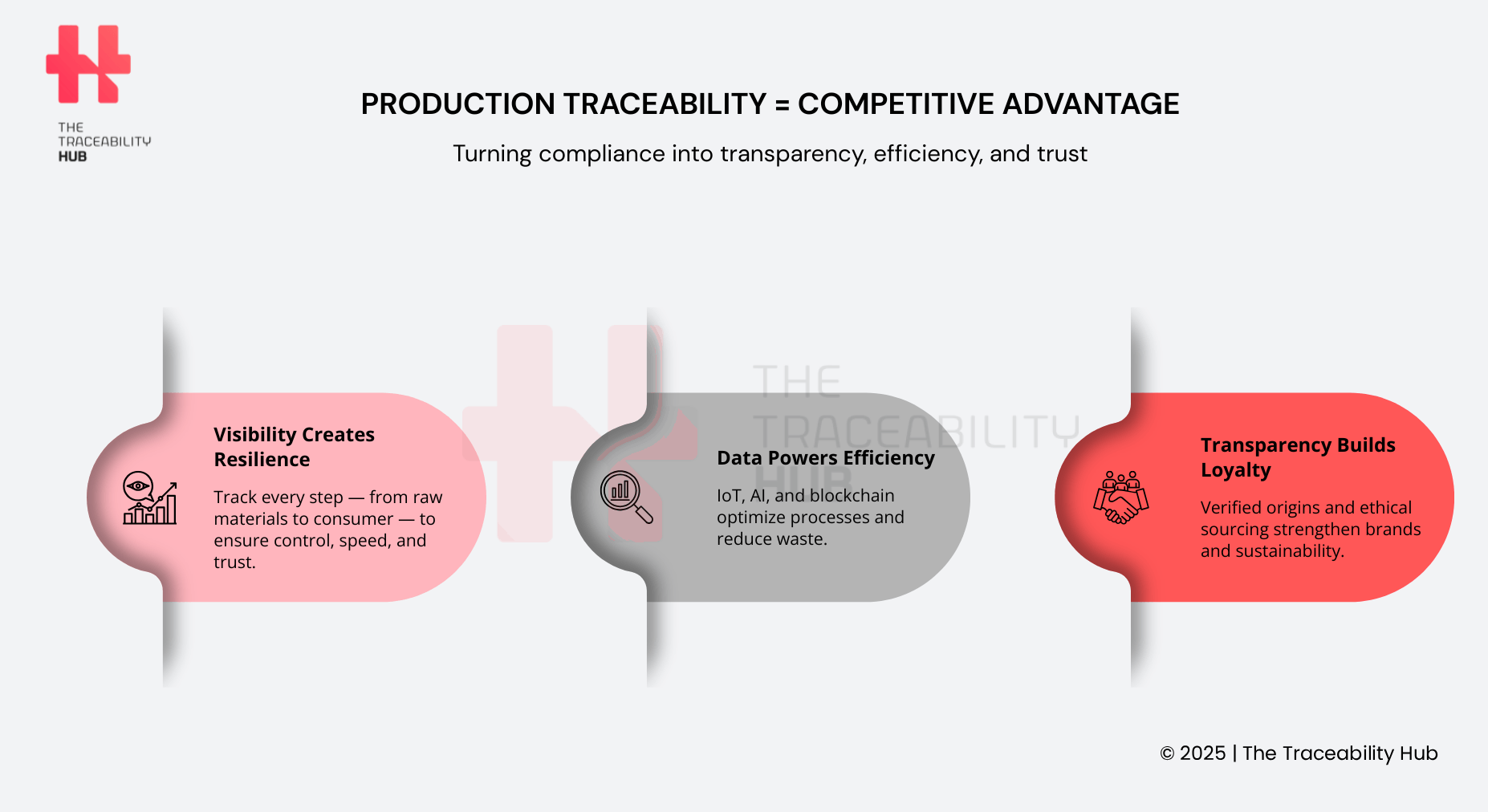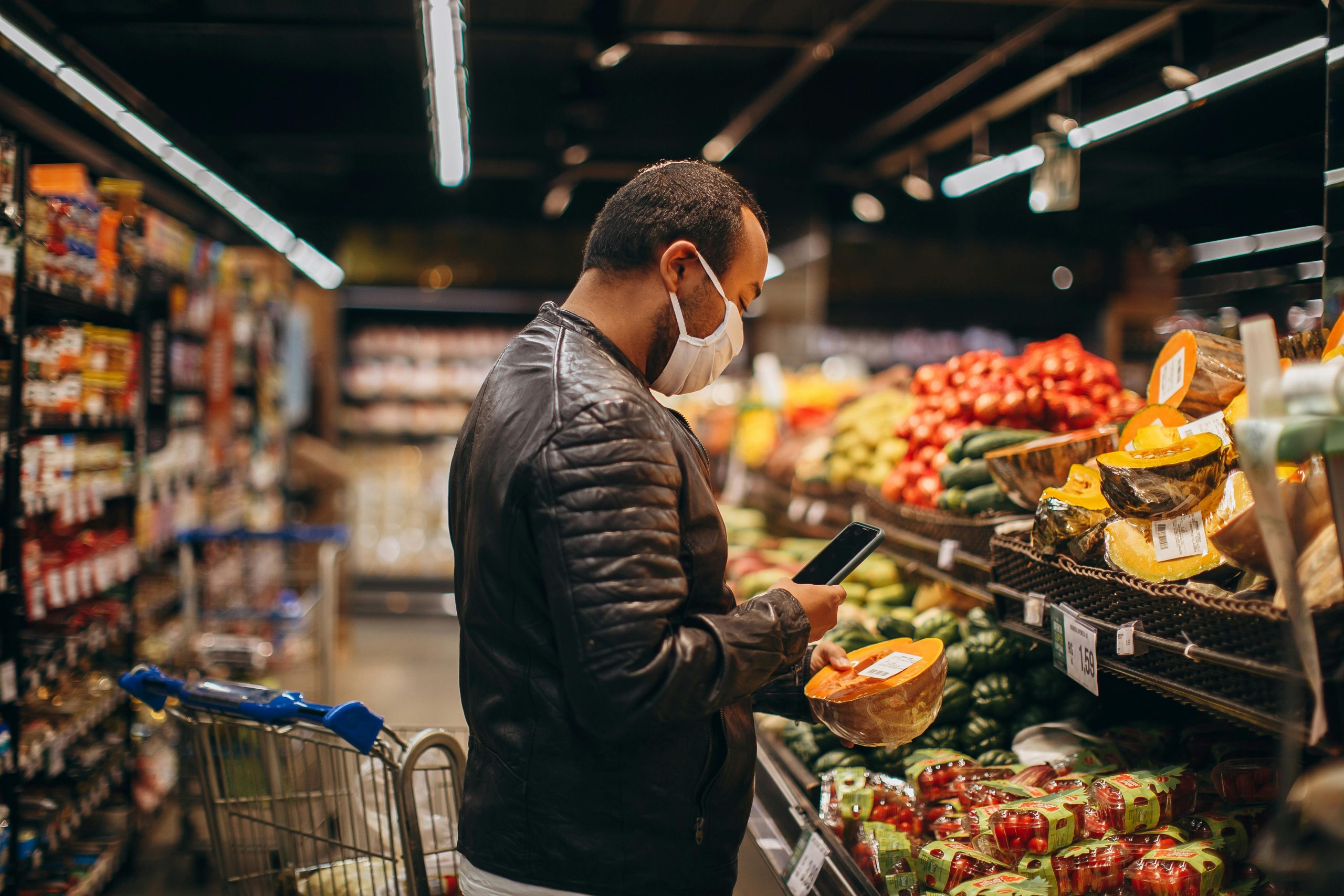The Key to Supply Chain Transparency and Resilience
In today’s interconnected global supply chain, the ability to track and trace products throughout the entire production process is no longer a simple regulatory requirement, it’s a critical element of supply chain transparency and business performance.
End-to-end production traceability has evolved from a compliance-driven obligation to a strategic advantage that enables companies to boost efficiency, trust, and sustainability across operations. By adopting digital traceability solutions, businesses can ensure full supply chain visibility, strengthen brand reputation, and respond faster to market disruptions.
For organizations in life sciences, food and beverage, cosmetics, and the chemical industry, the deployment of advanced traceability technologies is ushering in a new era, one where digital transformation drives transparency, accountability, and operational agility. These capabilities form the foundation for long-term competitive advantage and supply chain resilience.
This article explores the transformative power of production traceability systems, highlighting how leading companies leverage end-to-end digital traceability not only to achieve regulatory compliance, but also to unlock tangible business value, optimize supply chain performance, and gain measurable market differentiation.
Production Traceability = Competitive Advantage

Evolving Role of Traceability in Modern Supply Chains
Traditionally, traceability initiatives were developed out of necessity, created to meet regulatory compliance or in response to product recalls and safety incidents. While compliance remains essential, the traceability landscape has fundamentally evolved.
Today, leading organizations recognize traceability in supply chain management as a strategic enabler of brand differentiation, operational excellence, sustainability, and customer loyalty. What once served as a compliance checkbox is now a cornerstone of digital transformation and supply chain transparency.
Example: Pharmaceutical and Global Manufacturing Traceability
Global pharmaceutical manufacturers are implementing scalable labelling and traceability solutions that streamline compliance with major global regulations, such as the EU Falsified Medicines Directive (EU FMD) and the US Drug Supply Chain Security Act (DSCSA).
These digital traceability systems not only ensure regulatory adherence but also provide real-time supply chain visibility and operational agility. Through end-to-end production traceability, companies can monitor global manufacturing sites, identify potential issues instantly, and reduce recall response times significantly, enhancing both safety and efficiency.
What is End-to-End Production Traceability?
End-to-end traceability refers to the ability to track and document every stage of the product lifecycle, from the origin of raw materials through manufacturing, distribution, and finally, to the end consumer. This continuous flow of verified data forms an unbroken digital thread that connects suppliers, manufacturers, logistics providers, retailers, and consumers across increasingly complex global supply chains.
Key Drivers Behind the Shift Toward Digital Traceability
- Globalization and supply chain complexity: As global supply chains expand across multiple continents, the risks of disruption, counterfeiting, and quality failures increase exponentially. End-to-end supply chain traceability enables brands to identify risks early, maintain real-time visibility, and ensure operational resilience.
- Consumer expectations and brand transparency: Modern consumers demand ethical sourcing, sustainability, and verified product origin. Brands that can demonstrate traceable sourcing and transparent production practices build brand trust and customer loyalty, gaining an edge in the competitive consumer goods market.
- Technological advancements: Emerging technologies, including Internet of Things (IoT), blockchain traceability, artificial intelligence (AI), and cloud computing, have made granular, real-time supply chain visibility not only achievable but scalable. These innovations create digital ecosystems where data flows seamlessly between suppliers, manufacturers, and distributors.
- Regulatory pressure and industry standards: Governments and industry regulators are introducing stricter traceability and compliance frameworks, especially in life sciences, food and beverage, cosmetics, and chemical manufacturing. Adopting robust traceability technologies has become a market access requirement and a guarantee of consumer safety.
From Compliance to Business Value: The Strategic Case for Traceability
While regulatory compliance will always be a foundational requirement, the business case for traceability extends far beyond simply avoiding fines or satisfying auditors. Today, digital traceability systems have evolved into a strategic asset that drives supply chain transparency, brand trust, and sustainability leadership.
Enhancing Brand Trust and Market Access
An impeccable traceability record helps brands demonstrate authenticity, quality assurance, and ethical sourcing, key pillars for building long-term brand trust with consumers, retailers, and partners.
For export-oriented organizations, robust end-to-end traceability is now a prerequisite for accessing high-value markets such as the EU, United States, or Japan, where traceability compliance and product verification are tightly regulated.
Example:
A leading infant formula manufacturer delivers digital product serialization and end-to-end traceability for every can sold in China. By assigning unique scannable QR codes, consumers can verify product authenticity, view production details, and report suspicious items, boosting consumer confidence, brand loyalty, and market share.
Agility in Crisis Management and Recall Readiness
Product recalls and safety incidents can cause massive financial and reputational damage. Advanced track and trace technology allows businesses to quickly identify affected batches, perform targeted recalls, and maintain transparency with regulators and customers.
The ability to provide real-time product history data enhances crisis management and can turn potential setbacks into examples of operational excellence.
Example:
Global pharmaceutical and food & beverage companies now use integrated vision inspection and traceability systems to rapidly identify affected products in a recall. A major pharmaceutical manufacturer, leveraging an advanced track and trace platform, reduced recall investigation times from days to hours, improving public safety, regulatory compliance, and brand reputation.
Operational Efficiency and Cost Optimization
By digitizing and automating traceability data capture, organizations gain real-time supply chain visibility into inventory, production bottlenecks, supplier performance, and quality metrics.
This data-driven visibility enhances decision-making, reduces waste, and improves resource allocation, leading to measurable cost savings and increased operational efficiency.
Example:
A major food and beverage company implemented a centralized labelling and traceability system across multiple facilities, achieving a 40% reduction in labelling errors and significant savings in production downtime.
Facilitating Sustainability and ESG Goals
ESG (Environmental, Social, and Governance) factors are now at the core of business strategy. Traceability solutions empower companies to verify sustainability claims, ensure ethical labor practices, and monitor their carbon footprint, aligning with both regulatory frameworks and consumer expectations.
Traceability in fashion, food, and pharma industries enables supply chain transparency that supports sustainability reporting and strengthens brand reputation.
Example:
A global fashion and sportswear brand uses granular traceability technology to track raw material origins, verify supplier compliance with sustainability standards, and communicate verified data to consumers. This enhances environmental accountability, consumer trust, and ESG performance while reinforcing brand loyalty.
Enabling Product Innovation and Differentiation
Detailed traceability data unlocks powerful insights into product performance, consumer behavior, and supply chain dynamics. By analyzing this information, brands can drive innovation, product customization, and faster time-to-market, gaining a strong competitive advantage in crowded markets.
Example:
A premium olive oil producer adopted a blockchain-based traceability solution, offering consumers access to the complete journey of each bottle, from the olive grove to the store shelf, via a simple QR code scan. This blockchain traceability not only built consumer trust but also supported premium pricing through verified authenticity and provenance.
Technological Foundations of Advanced Traceability
The leap from basic compliance to achieving true competitive advantage in modern supply chains is powered by the adoption of advanced digital traceability technologies.
Key technological pillars include:
- Cloud traceability platforms: Modern, centralized, and scalable cloud-based platforms enable seamless data sharing across global operations and with external partners, supporting collaborative, transparent, and resilient supply chains.
- Internet of Things (IoT) traceability: Smart sensors and IoT devices monitor production and distribution in real time, capturing environmental data such as temperature, humidity, and movement. These IoT-enabled traceability systems ensure end-to-end visibility and make granular traceability seamless and scalable.
- Blockchain technology in supply chain: Blockchain traceability solutions provide a distributed ledger that guarantees data integrity, immutability, and transparency—making it nearly impossible to tamper with product records and reinforcing stakeholder trust.
- Artificial Intelligence and analytics: AI-powered analytics uncover hidden patterns, predict potential risks, and provide actionable insights for proactive supply chain risk management, demand forecasting, and predictive maintenance.
Sector-Specific Perspectives: Why Traceability Matters More Than Ever
While the value of traceability technology is universal, its impact varies across industries. Let’s explore how advanced traceability systems are redefining supply chain excellence and competitive advantage across four key sectors: life sciences, food and beverage, cosmetics, and chemicals.
Lifesciences: Safeguarding Patients and Accelerating Innovation
In the life sciences industry, pharmaceutical traceability is critical for patient safety and regulatory compliance. Frameworks such as the EU Falsified Medicines Directive (EU FMD), the US Drug Supply Chain Security Act (DSCSA), and Good Manufacturing Practices (GMP) demand end-to-end tracking and documentation.
Beyond compliance:
- Counterfeit prevention: Serialization and digital traceability prevent counterfeit drugs, protecting both patients and brand reputation.
- Clinical trial traceability: Tracking the provenance of samples and materials ensures data integrity and compliance with research protocols.
- Accelerated recalls: AI-driven traceability systems enable rapid batch identification, minimizing patient risk and enhancing regulatory responsiveness.
- Personalized medicine: End-to-end traceability links patient data with manufacturing and distribution, supporting precision therapies.
- Supply chain visibility: Real-time tracking of suppliers and inventory ensures resilient life sciences supply chains and reduced production delays.
Food & Beverage: Ensuring Safety, Authenticity, and Sustainability
In the food and beverage industry, food traceability systems are essential to maintaining safety and consumer confidence. Regulations like the US FDA’s Food Safety Modernization Act (FSMA) and the EU General Food Law Regulation are setting new benchmarks for food safety traceability.
Commercial and operational advantages:
- Rapid recall response: Blockchain traceability enables precise recall targeting, protecting consumers and brand reputation.
- Proving provenance: Verified origin data satisfies demand for organic, locally sourced, and sustainable food products.
- Allergen and ingredient transparency: Comprehensive ingredient tracking supports accurate labelling and reduces liability risk.
- Combatting food fraud: IoT and blockchain solutions authenticate product origin and prevent counterfeit food products (e.g., olive oil, honey, seafood).
- Sustainability verification: Traceability platforms record environmental and social impact metrics, supporting certification and ESG reporting.
Cosmetics: Building Trust through Transparency
The cosmetics industry faces growing scrutiny over ingredient safety, ethical sourcing, and sustainability compliance, especially under the EU Cosmetics Regulation and global green labelling initiatives.
Modern traceability platforms empower beauty brands to trace every ingredient back to its source, ensuring cruelty-free, vegan, and eco-friendly cosmetics.
Strategic benefits:
- Ingredient traceability: Tracking every component from raw material to finished product assures compliance and enables faster safety recalls.
- Ethical sourcing: Digital verification of supplier practices reinforces fair-trade and cruelty-free commitments.
- Supply chain transparency: Cosmetics traceability systems foster consumer trust and justify premium pricing for verified ethical products.
- Regulatory readiness: Automated traceability simplifies compliance audits and facilitates market entry in global regions.
Chemicals: Managing Risk in High-Stakes Environments
The chemical industry operates under some of the strictest safety and environmental regulations, including REACH (EU) and TSCA (US). Multi-tiered chemical supply chains introduce additional risk — from material sourcing to waste disposal.
Why advanced traceability is critical:
- Hazardous material tracking: Real-time chemical traceability systems prevent leaks, contamination, and unsafe disposal, safeguarding people and the environment.
- Regulatory compliance and audits: Automated data capture and digital recordkeeping simplify compliance with chemical safety standards.
- Supply chain risk mitigation: AI and predictive analytics identify at-risk suppliers, ensuring business continuity during geopolitical or environmental disruptions.
- Customer assurance: Detailed product provenance and digital transparency provide confidence in product quality, safety, and origin.
Realising the Full Potential: Success Factors and Best Practices
For organisations seeking to transform traceability systems from a basic compliance tool into a true competitive advantage, several key traceability best practices and success factors emerge. Implementing a strong digital traceability strategy helps companies unlock end-to-end visibility, operational efficiency, and supply chain resilience.
Adopt a Holistic Approach
Integrate supply chain traceability across all business functions, including procurement, production, quality control, logistics, and sales, to achieve complete end-to-end visibility.
A holistic traceability implementation ensures that data flows seamlessly throughout the organization, enabling faster responses, greater transparency, and cross-functional accountability.
Invest in Scalable Traceability Technology
Choose scalable and flexible traceability platforms that can evolve with your business and adapt to future regulatory compliance requirements.
Modern digital traceability solutions based on cloud infrastructure, IoT sensors, and blockchain technology provide real-time data integration and supply chain transparency, helping organizations respond quickly to disruptions and emerging trends.
Investing in the right traceability technology stack ensures that your systems can expand to support new geographies, multi-tier suppliers, and dynamic supply chain networks.
Foster Cross-Enterprise Collaboration
Build a connected traceability ecosystem by encouraging data sharing and collaboration with suppliers, partners, and customers.
This cross-enterprise integration strengthens supply chain resilience, enhances transparency, and helps businesses meet both ESG goals and consumer expectations for sustainability and ethical sourcing.
Collaborative data exchange also supports real-time risk assessment, compliance verification, and continuous improvement across the value chain.
Empower with Data Analytics and AI
Leverage traceability data as a strategic asset for predictive analytics, data-driven decision making, and performance optimization.
Using AI and machine learning, organizations can detect anomalies, anticipate supply chain risks, and identify opportunities for process improvement.
By integrating analytics dashboards and KPIs into daily operations, traceability shifts from a passive reporting function to a strategic intelligence tool that fuels continuous improvement and competitive differentiation.
Prioritize Change Management and Employee Engagement
Effective traceability adoption requires more than technology, it demands a strong change management strategy.
Train and engage employees at all levels to understand the importance of traceability compliance, data integrity, and digital collaboration.
Empowering staff fosters a culture of transparency, ownership, and innovation, ensuring that traceability initiatives succeed and deliver long-term business value.
Plan for the Future: Stay Ahead of Regulations and Trends
To sustain success, maintain a future-ready traceability strategy that monitors emerging regulations, consumer behavior, and technology advancements.
By anticipating changes in areas like sustainability reporting, ESG compliance, and product traceability requirements, organizations can stay ahead of the curve and turn adaptation into a competitive advantage.
Continuous innovation, coupled with proactive supply chain monitoring, ensures that your traceability framework remains agile, scalable, and compliant in a fast-evolving global market.
New Mandate for Traceability Leadership
The evolution of traceability from a reactive compliance measure to a proactive business enabler marks a turning point for industries worldwide. In life sciences, food & beverage, cosmetics, and chemicals, the organisations that invest in robust, end-to-end traceability infrastructures are not just protecting themselves from regulatory penalties—they are unlocking commercial value, safeguarding their brands, and building supply chains for the future.
The imperative is clear: in a world where trust, transparency, and agility are the currency of competitive advantage, traceability is no longer optional. It is a strategic asset—one that shapes reputations, accelerates innovation, and prepares organisations to thrive in an uncertain world. Manufacturers that embrace this new paradigm will not only meet the demands of today but will lead the markets of tomorrow.
Read more: Solving Global Tobacco Tracking: Essential Tech Behind Supply Chain Compliance






